
Monthly Archives: June 2011
Gourmet Underground Detroit's content archives are organized by date and catalog the aggregated content of our Features pages as well as our blog.
Rye Tasting
Distilling rye has a history in America that extends back into the 1700s, a practice that was regularly undertaken by eastern settlers with surplus grain. George Washington was even among those who made whiskey from his rye, a fact which certainly must qualify it as one of our country’s classic spirits. Hence, Gourmet Underground Detroit felt it was our duty as Americans to taste through an assortment of this chronicled beverage.
Equal parts stout patriot and mad genius, my dear friend John thus organized a small group of folks — he and I were joined by Karla and Noah — to gather at his apartment in Northville to taste through a half dozen rye whiskeys.
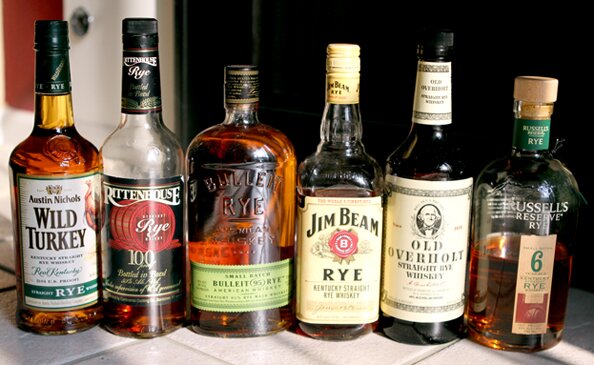
Unfortunately, Sazerac brand rye, which is generally one of the commonly available ryes in Michigan, is in short supply at the moment, or so we were told by several store clerks in western Wayne County. But we had the other notable state-sanctioned products — Jim Beam, Wild Turkey, Russell’s, and Bulleit — as well as two ryes that are among the most popular across the counry in the form of Old Overholt and Rittenhouse 100.
None of these are terribly expensive, and we intentionally ignored products like the $200 aged Rittenhouse product or the “Ri” whiskey from Jim Beam, which at $40+ on the retail shelf isn’t something with which most people would be interested in mixing.
Setting aside our observations and opinions for a couple of paragraphs, it’s worth mentioning a few basic facts about rye, especially considering that it has a pretty limited following in the metro Detroit area.
Whiskey of all sorts is essentially just a distillation of a rudimentary beer. Most whiskey we drink has been aged in barrels for some length of time. Bourbon, arguably the more familiar whiskey to most Americans and certainly to most Detroiters, contains at least 51% corn in that grain mixture. Rye, by contrast and by law, must contain at least 51% rye. The remainder of the grain bill can be just about anything, though in the case of rye whiskey, those grains are generally corn, wheat, and/or malted rye.
Maryland, Pennsylvania, New York, and Virginia were all states noted for their rye traditions, with unique characteristics ascribed to each. After WWII, many of the notable bottlers were bought up and shut down or sold again, and those that stayed open were gobbled up by larger companies. Indeed, Pikesville, a perfectly pleasant drink with a nice fruity nose and smooth flavor, is a whiskey long associated with Maryland. But it’s now manufactured in Kentucky, “rescued” by Heaven Hill distilleries. The same applies to Rittenhouse, a brand in our tasting that represents Pennsylvania rye.
Indeed, as with most spirits, the landscape changed considerably after Prohibition. Bourbon gained favor with whiskey drinkers, and vodka seemed to catch on with everyone else.
Fortunately, we’re in the midst of something of a rye renaissance. In addition to the large-scale products that are enjoyable – like Rittenhouse or Overholt – producers like Tuthilltown, Anchor, and Whistlepig are creating new, smaller batch products that seem to be catching on for drinking straight or use in particularly high end cocktails.
In that spirit of renewal, here are our notes from the tasting. We drank the whiskeys blind, and the notes below are presented in the order in which the ryes were consumed.
Jim Beam Rye
The initial reaction from the entire crowd was that the whiskey didn’t taste like much of anything. There’s a slight sweetness with just a bit of vanilla barrel flavor and a mild spiciness. Very mild body. But beyond that, the Beam was inoffensive enough to be passable for cocktails but rather uninspiring otherwise.
 Russell’s Reserve 6
Russell’s Reserve 6
As Noah immediately mentioned, this was lighter in color than our first blind entry: Russell’s 6-year was more of a yellow-ish color than most whiskey. Aromatically, this was simply weak – not much there. On the palate, it was so bland as to be insipid. Karla didn’t get past two sips before passing hers off. There was barely a spiciness to it, something that one commonly expects in a rye, and it ended with a strange bitterness that, while mild, was off-putting. I’ve mixed Russell’s in plenty of drinks and not been too upset about it, but in this naked setting, it was clearly outmatched.
Bulleit Rye
Standing in stark contrast to the first two, this screamed with unique flavors and smelled of honey and herbs. I was somewhat alone in thinking that it had a thyme-ish quality in the nose. The spiciness was prickly but only accompanied by the most mild alcohol burn, and a light honey sweetness with a bit of toffee bitterness in the finish continued throughout the drink. It lasts a long while with that herbal, woody, toffee flavor making for a fairly savory rye. Of course, rye is the grain responsible for those flavors and for spice, so it should come as no surprise to newcomers to this product that it contains 95% rye, an unusually high percentage.
Rittenhouse 100
Arguably the most powerful of the ryes, this was obviously a 100 proof whiskey from the get go. In terms of complexity, it suffered coming immediately after the Bulleit. But as the most potent beverage in the tasting, spiciness and booze shone through with a mild, grassy finish. This is a clean, edgy whiskey that manages to be quite dry and full at the same time.

Old Overholt
Sort of a middling option from the first whiff, this had a bit of spice, a bit of sweetness, a bit of vanilla, and a bit of maple on the nose and honey on the palate. Lower in alcohol, it was immediately characterized as being rounder and while not widely rejected by our group, it wasn’t beloved either. Of course, this is still a value: It’s less than 15 bucks just about anywhere you can find it (not in Detroit), and in a pinch, it gets the job done. In the price range, it’s clearly a better option than Beam.
Wild Turkey
This is the most well-rounded whiskey. It had some body and some mild spice, but despite its higher proof, it’s not at all hot. And however it’s aged, it results in a pleasant, mild vanilla flavor. This whiskey also ranked highly with everyone, and considering the price and the fact it’s readily available in Michigan, it would arguably be our “go to” rye in the state.
* * * * * *
The Manhattan Project
Drinking straight whiskey is fun. No one would deny that. But in the interest of scientific exploration, we elected to make some Manhattans with the top three ryes from the tasting. If it wasn’t obvious from the notes, we chose to use Bulleit, Rittenhouse, and Wild Turkey.
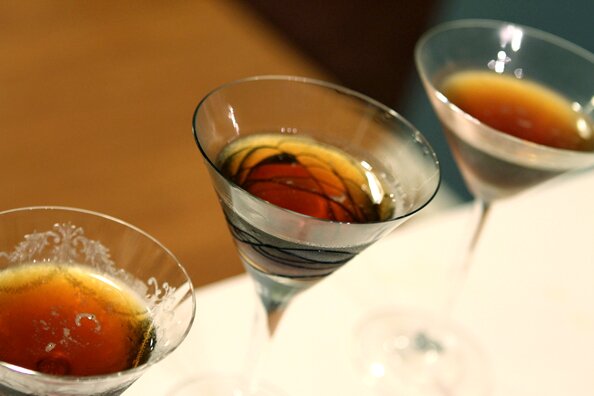
John and Noah preferred the Bulleit best, whereas Karla preferred the Wild Turkey, and I preferred the Rittenhouse. The Bulleit certainly had a lot of flavors going on, though in my mind, it clashed a bit, adding a spicy smoke flavor to a drink that might not best carry those particular sensations. What one man considers complex might be another man’s confused, and vice versa. Wild Turkey carried its round, pleasant qualities through to the Manhattan and blended seamlessly. Rittenhouse created, for me, the most interesting drink: pleasant but not simple, complex but not awkward, spicy but not hot.
A certain someone hosting the tasting disagreed with my assessment and offered this unkind gesture:

It’s hard to lose with any of these three whiskeys — either for drinking straight or for drinking in a cocktail — but for Michiganders not looking to ship from out of state, Wild Turkey is the clear winner.
A Handful of Premium Chinese Tea
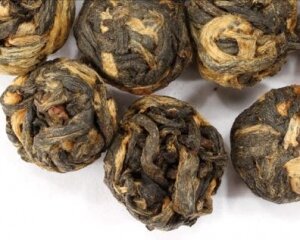 Yunnan is the southern Chinese province bordering Vietnam and believed to be the birthplace of tea. It produces more black tea than any other part of China. For a unique cup try Yunnan’s black tea version of the popular Dragon Pearl. The large leaves are rolled into firm spheres of brown and gold and as the pearls steep they unfurl and release a liquor that is sweet and smooth with a hint of fertile soil. Deep aromas of malted barley swirl around more subtle notes of cocoa. It’s tasty hot or cold.
Yunnan is the southern Chinese province bordering Vietnam and believed to be the birthplace of tea. It produces more black tea than any other part of China. For a unique cup try Yunnan’s black tea version of the popular Dragon Pearl. The large leaves are rolled into firm spheres of brown and gold and as the pearls steep they unfurl and release a liquor that is sweet and smooth with a hint of fertile soil. Deep aromas of malted barley swirl around more subtle notes of cocoa. It’s tasty hot or cold.
From the mountains of Qimen County in the Anhui province of eastern China comes a black tea comparable to the famous Darjeeling. Keemun (the English spelling of Qimen during the colonial era) is the name. Hao Ya A (Downy Buds Grade A) is the highest grade possible and the tea you want in your cup. The tiny black leaves with golden buds produce aromas and flavors that have been described as floral, port wine, pine smoke, biscuits and orchard fruits, in other words, complex. It makes a kick-ass iced tea, too.
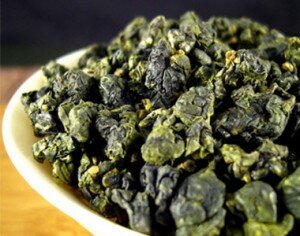 Known to embody the essence of Taiwan’s mountains and rivers, Dongding oolong tea immediately engages with a nose of sultry blooms, mown grass and water crackers. Grown in Nantou County of central Taiwan, Dongding is the most popular tea on the island. Only partially oxidized and lightly roasted, the tight, curled leaves expand several times and last through numerous steepings. A cup is clear, pale yellow touched by green. A full and gently sweet body belies its delicate appearance. It makes a fine, balanced iced tea.
Known to embody the essence of Taiwan’s mountains and rivers, Dongding oolong tea immediately engages with a nose of sultry blooms, mown grass and water crackers. Grown in Nantou County of central Taiwan, Dongding is the most popular tea on the island. Only partially oxidized and lightly roasted, the tight, curled leaves expand several times and last through numerous steepings. A cup is clear, pale yellow touched by green. A full and gently sweet body belies its delicate appearance. It makes a fine, balanced iced tea.
Black tea from the Fujian province on the southeast coast of China, Lapsang Souchong is one of the more unique teas you’ll ever come across. Dried in bamboo baskets over burning conifer, it is redolent of sap and smoky campfires. These aromas combined with the sweet and tangy liquor create a sip reminiscent of the wet decay of a cedar forest. A quality Lapsang Souchong is a transcendent drink for those of us captivated by all things smoked. Drinkers into highly-peated Scotch should dig it. It’s also handy in the kitchen for flavoring everything from vegetarian stew to oven-baked ribs.
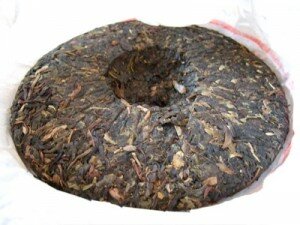 Since the Eastern Han Dynasty the Chinese have been taking broad leaf tea from around the southwestern province of Yunnan, fermenting it and then compressing it into bricks or cakes. The finished product can be drunk immediately but if made well it can mature into a dark, mellow and unique tea fragrant with dried fruit, mushrooms, camphor and flowers. As with wine, only finely made and properly stored pu-erh teas will improve with age and increase in value.
Since the Eastern Han Dynasty the Chinese have been taking broad leaf tea from around the southwestern province of Yunnan, fermenting it and then compressing it into bricks or cakes. The finished product can be drunk immediately but if made well it can mature into a dark, mellow and unique tea fragrant with dried fruit, mushrooms, camphor and flowers. As with wine, only finely made and properly stored pu-erh teas will improve with age and increase in value.
To sample and learn about high quality tea in a relaxing atmosphere, check out Goldfish Tea in Royal Oak.
GUDetroit picnic 2011
It was an event we’d been anxiously awaiting for several weeks (although some may have feigned otherwise- you know who you are): the second annual GUDetroit picnic on Belle Isle. You may remember my post about last year’s picnic, a 9-hour marathon of food, drink and camaraderie that began shortly after noon and ended only when the last rays of sunlight were extinguished and the city lights began to twinkle across the river in their place. This year was no different in that respect, and once again I was among those packing up at the end of the night after most everyone except Todd and Evan had gone home.
Marvin and I didn’t make it to the picnic until almost 4pm so I missed a few folks who had already come and gone, but for the most part, people were there for the duration (and we weren’t the last to show up by a long shot). There were many familiar faces but just as many new ones, with overall turnout a bit higher than last year- we’re an ever-expanding group! As is often the case with social gatherings whose genesis is online, I wasn’t quite sure whether to just randomly introduce myself to unfamiliar people, even knowing that we’ve likely corresponded in some shape or form already. Some were forthcoming with introductions and others preferred to remain anonymous. Maybe we’ll have to do a name tag thing next time. As long as everyone promises not to write their Twitter handle on it.
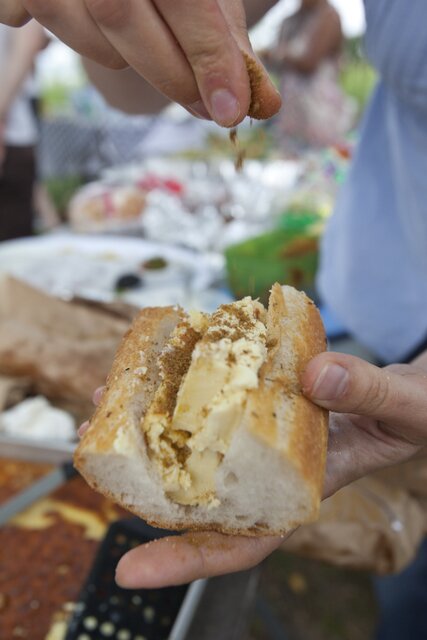 One person I was definitely looking forward to meeting was Warda, a fellow blogging friend I recently wrote about whom I’d never met in person. She came with her husband and two darling little girls and brought karantika (photo at left), a savory flan made with chickpea flour that is a popular street food in Algeria. Although they have lived in the Detroit area for years, it was their first visit to Belle Isle, and I was pleased to have a hand in that.
One person I was definitely looking forward to meeting was Warda, a fellow blogging friend I recently wrote about whom I’d never met in person. She came with her husband and two darling little girls and brought karantika (photo at left), a savory flan made with chickpea flour that is a popular street food in Algeria. Although they have lived in the Detroit area for years, it was their first visit to Belle Isle, and I was pleased to have a hand in that.
As the evening wore on, things got loopier, with manly naps and snuggles on picnic blankets, tree-climbing, raucous games of cornhole for all ages, mint-spanking, swinging from willow branches, and even some half-baked attempts at hula-hooping. We finally packed it up well after dark, with a few hardy souls carrying on the festivities back in Ferndale.
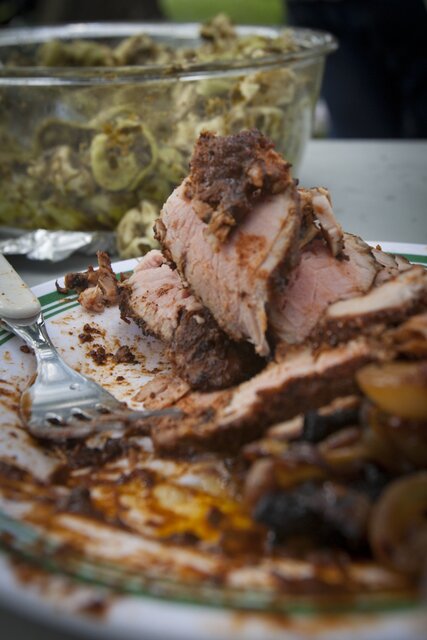
Now that you’ve read this far, I’m sure you’re saying to yourself “BUT WHAT ABOUT THE FOOD?!” I hope no one throws rotten tomatoes at me if I say that I thought the spread was slightly more impressive last year. But maybe that’s just the rose-tinted spectacles of hindsight… the “first time” of anything often holds a special place in one’s memory, and last year’s picnic was pretty darn magical. There were some definite highlights this year though, like grilled feta with honey, anise and other herbs, homemade sausage, pork tenderloin, elote, and Warda’s karantika. The mini pavlovas looked enticing but were gone before I could try one. And judging from the speed at which the 5 pounds of kefta and kebabs I brought were devoured, I’d say those went over pretty well too.
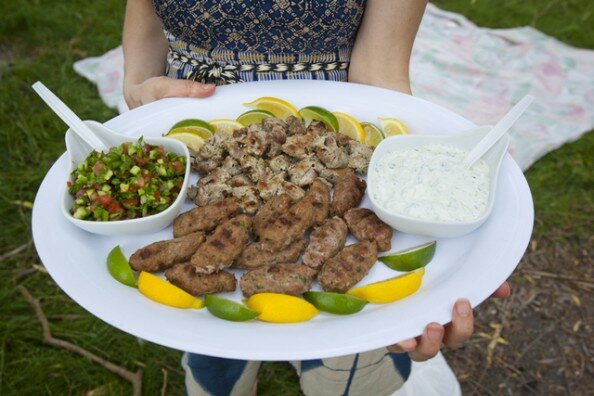
For even more photos of the picnic as well as the kefta and kebab recipes, you can hop over to my blog. And anyone who’s posted photos on flickr or elsewhere, please share links (unless of course they happen to contain photos of a certain, ahem, over-aged hula hooper).
Fragaria Perfecta (or, “Damn, That Works”)
Suz asked me to make her a drink with the tasty, local strawberries we had. I figured that if I was going to make a drink, I might as well make it a pretty fucking awesome drink.
Fragaria Perfecta
1.5 oz gin
.75 oz lemon juice
.5 oz green chartreuse
.25 oz simple syrup
4-5 fresh, in season strawberries
rosemary
I muddled the berries, rosemary, and simple together in the shaker, then added my other ingredients and shook with ice. Always double strain given the amount of debris in the cocktail. Served up. Be sure to take a moment to enjoy the intensely rich red color before sucking it down. Drink one after dinner. Or before dinner. Or with your pancakes.
I ran out of rosemary, so I couldn’t try this, but I think this would be a great addition to garnish with a small, fresh sprig across the rim of glass. I might also try this with a rosemary-infused gin to start with rather than muddling it in. Next time.
Summer Hopquila Recipe: Lemon Rabbit Cocktail
New Holland Brewing’s Hatter Royale Hopquila isn’t what you’d expect. Hopquila is a close relative of tequila, but with a hint of hops that smooths the spirit. Don’t bother with limes or triple sec, and don’t mess around with blenders—Hatter Royale Hopquila is unique, beautiful in its simplicity, and surprisingly drinkable.
The hops, oddly, adds not so much a floral IPA quality to the Hopquila, but a saltiness that creates a tempered tequila flavor, and makes it perfect for mixing with citrus. Hopquila is for sipping—starts sweet, goes down smooth, and finishes with a hint of hops. A grain-neutral spirit, made from 100% barley, distilled twice, then steeped in Centennial hops, Hopquila is “vivacious,” as New Holland describes it, with a “grain-centric body framed by citrus-laden hop character in the nose and finish.”
Metro Detroit mixologist, Brian Doughty, developed a simple recipe that takes note of the one-of-a-kind hops flavor. He rolled out the cocktail at the June 11 Gourmet Underground picnic on Belle Isle in Detroit, which is where the drink earned the name, “Lemon Rabbit.” Open a bottle and hop down the Hopquila hole:
Lemon Rabbit Recipe
Over ice:
2 oz. Hopquila
1 oz. Fresh-squeezed lemon
1 oz. Tonic water
The aforementioned saltiness of the Hopquila cuts the lemon, and vice versa, and the tonic makes the drink lighter and more refreshing than a margarita. In fact, it’s not entirely accurate to compare the Lemon Rabbit to a margarita, but that’s probably as close an analogue as is available—a lemony margarita with fizz, or a hybrid between a margarita and lemonade.
Enjoy in the sun, and be careful.
__________________________________________________________
Tim Chilcote, writer and Great Lakes enthusiast, blogs at www.greatlakesguru.com. Follow him on Twitter @TimChilcote.
From the Charente to Oaxaca
Despite being situated near the few Californian wineries I enjoy, Ukiah was a town unfamiliar to me. But over the days following my first sip of Maison Surrenne cognac, I began to do a bit of reading on the producer and the US-based representative of the product, a company out of Ukiah called Craft Distillers.
My simple 10 minutes of web research turned into an eye-watering 5-hour journey down the web research rabbit hole. I’m officially adding brandy to the list of drinks to which I’m more or less addicted.
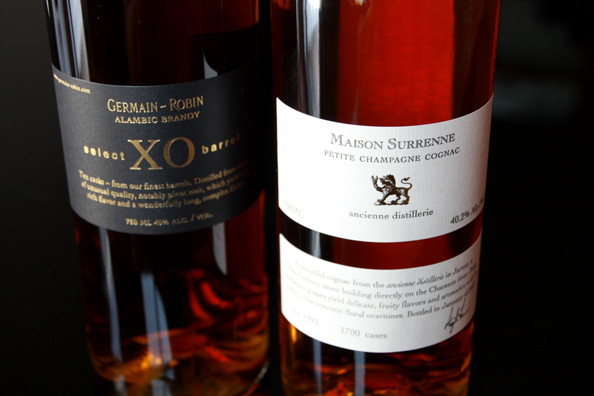
Ansley Coale, who has been kind enough to read and comment on my previous cognac blog post, founded Craft Distillers to help distribute artisanal spirits ranging from cognac to mezcal, whiskey to rose liqueurs. He’s also involved in a distillery in Ukiah that carries the name of his partner, Hubert Germain-Robin, the latest in a long line of brandy producers, albeit the first on this side of the Atlantic.
Having now sampled that California brandy, two cognacs, a mezcal, and a rose-infused liqueur, I feel confident saying the items with which Mr. Coale associates himself are superb examples of their various styles and among the better spirits I’ve had recently.
His products – save Hangar One vodka, which he sells to subsidize his other endeavors – are not available in Michigan (of course), but they are worth saving up for and hunting down. I posted about my first bottle of Maison Surrenne Borderies, but there are some additional notes below.
Finally, I’ve also learned a thing or two about appropriate glassware. While I don’t subscribe to the theory that 20 different wines or beers require 20 unique glasses, I certainly hold it to be true that glassware has an effect on what we taste. In this case, the claims that a tulip glass are superior to a snifter are unquestionably true. Snifters create a more volatile, hot drink, whereas the tulip glass seems to emphasize the fruit and barrel flavors.
So armed with a tulip glass, I went about sampling some new drinks (Photos are courtesy of Chance Landrews, staff photographer at the Sugar House Bar):
Maison Surrenne, Petit Champagne Cognac, Lot 1991
There’s the same buoyant, delicate quality as the Borderies (as noted in my previous post on cognac, Bordieres and Petit Champagne are specific regions within Cognac) I’d had previously. But it isn’t so rich and silky, nor is it as clearly violet scented or flavored. More so, it has subtly sweet, fleshy fruit qualities. The finish is a bit hotter and spicier, though that’s not to say it’s inelegant. Quite the opposite. It’s a very well-balanced drink. Compared to this region, Borderies is supposed to have richer soil due to river deposits, and that’s unsurprising — this has a stonier, sharper edge.
Germain-Robin XO Select Barrel
This couldn’t be more opposite than the Surrenne above. The wood shows more of its role here in the form of a much richer, denser body. Aromas of caramel and grilled/baked fruits. Oaky vanilla flavors, though the caramel isn’t noticeable on the palate. And then there’s the fruit. I don’t know enough about brandy to understand if this relates to the distillation process or to the heavy amount of American pinot noir, but there’s a strawberry and apricot nose to this and very subtle red fruit flavors. I didn’t sense them in my first taste, but the more I got accustomed to this drink, the more I became fixated on some of these fruitier flavors rather than the barrel flavors. Regardless, this is a deep spirit, equally potent and nuanced.
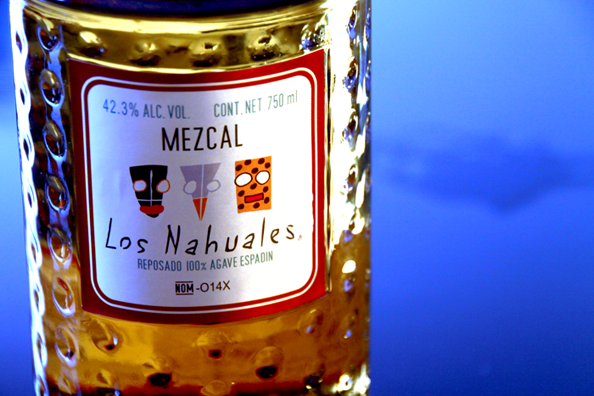
Los Danzantes Los Nahuales Reposado
I’ve had much smokier mezcals, though I always get the feeling that they’re smoky to cover something else up. Not so here. Instead, this has true depth from the first whiff through the lingering finish. There’s a certain orange-ish flavor reminiscent of some Irish whiskies, but it’s dominated by a sweet, pleasant smokiness. It’s not salty in the way scotch can be, but it has a mineral quality about it that lends a similar edge. I’m hardly a mezcal expert, but some friends who were tasting with me – Dave from Sugar House and James from Great Lakes Coffee – and I have had Del Maguey, Arette Gran Classe Anejo Tequila, and/or other, similar drinks, and this absolutely belongs in that class. A real treat.
The quality prompted me to do some reading, and it turns out that this is aged in French oak, rather than American, and that the brothers who produce the product use very sweet, mature agave in the distillation and aging. Also, take a peek at the label: This is essentially a varietal mezcal, using the one type of agave, espadin. There are numerous others. Further research is required.
Crispin’s Rose Liqueur
This is the purest expression of a macerated fruit, herb, or flower I’ve ever had. The distiller, Crispin Cain, distills a mead with apple (if I recall correctly, a mead-cider hybrid is called a cyser) to form the base for this spirit, into which goes heirloom rose petals. It’s drier than it smells, though it’s certainly still kissed by sweetness. To smell this, though, is to smell a rose. Great flowers have a depth to their aromas, and this liqueur expresses that sensation. It’s plump. And on the tongue, there’s more of the same, though again, accented by that honey-ish sweetness. It’s a bit too pricey for me to turn this indulgence into a regular habit, but I’m genuinely pleased to have tried it.
It’s a shame these aren’t available here. But like I said, they’re worth seeking out.
Eating in Season
My family likes salad as much as anybody. Give us a plateful dressed in tangy vinaigrette and we’ll devour it in minutes. Whether as a side, or a complete meal, we’ll munch a fresh salad every day of the week when the ingredients are in season. But what’s up with the local produce at Eastern Market? You’d think we could get a couple of Michigan grown cucumbers and tomatoes to go with those tasty Brother Nature greens to make a proper salad. We are a premier agriculture state, I’m told.
The truth is, we are so used to seeing the same fruits and vegetables year round in the grocery store most of us don’t even know what is in season anymore. Unless we tend our own vegetable garden, or buy directly from local farmers, how do we know that Michigan lettuce is ripe for picking while most Michigan tomato vines aren’t even flowering yet?
It’s not exactly rocket surgery. Certain plants fruit at different times of the year and in different places based on climate. But it is an idea that’s distorted by our appetite for choice in the marketplace. Perceived choice, that is.
It’s a shame because food eaten in season not only tastes better, it is more satisfying. Isn’t a steaming creamy bowl of Butternut squash soup vastly more agreeable slurped on a chill day in October than on a sun-soaked patio in July? That’s an easy one.
Eating in season goes far beyond the hedonistic value of the food. There is no question that local fruits and vegetables are higher in nutrients than produce that has spent days traveling to a distributor before ever being placed for sale in a bin. Hybrid grocery store produce is designed to withstand long journeys and still look good, never mind the taste or nutritional value. Many times it is even picked prematurely and then artificially ripened.
By aligning our consumption with the seasons, we will be getting a range of nutrients simply through the variety of locally grown food available. Nutrients likely more in tune with our bodies current needs. Eating such a variety might even help avoid food allergies and intolerances.
How about the environment? Before we even account for non-organic growing practices, imagine the cost in fuel and the pollution generated to ship out of season fruits and vegetables to Michigan compared to what’s grown here, sometimes from countries that might have issues feeding their own population.
What’s more, it’s generally no huge agriculture conglomerate that is prospering when we eat in season. It is the local economy that retains most of our dough. In our case, farmers we know, and the businesses that support locally grown produce.
We don’t have to get militant about it either. We do treat ourselves to the occasional pineapple, mango or avocado from time to time. Yet we also know that committing to locally grown and seasonal produce is a big leap in the right direction.
Now we make our salads with mostly what is fresh and available from our trusted farmers at the market. Who knew that Brother Nature greens tasted just as good with radishes, peas, sunflower sprouts, asparagus and spring onion? We’re getting back to our roots (so to speak). Our ancestors ate in season. They ate what they could grow or trade for. They ate in season out of necessity. We do it for health – the Earth, the local economy, and our own.
The USDA Presents: Choose My Glass
The food pyramid is gone. So needlessly complicated, and it legitimized mass processed sweets at the top. What gives? Thankfully, the USDA has released the new “Choose My Plate” program, which simplifies and clarifies what Americans should be eating.
But for all their hard work, they clearly overlooked an important part of the meal experience — drinks! So we at GUD have put together a similar graphic that we’re sure the USDA will approve and adopt any day now: Choose My Glass.
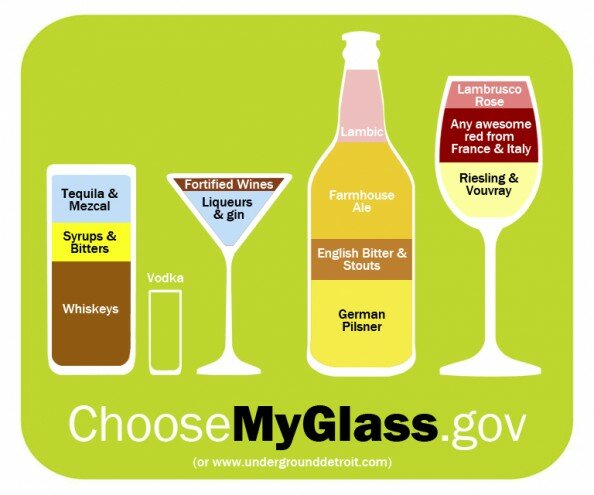 For reference, the original US government diagram:
For reference, the original US government diagram:

The Dirt on Farmer’s Market Vegetables
Fresh, locally grown vegetables are beginning to fill the tables at your local farmer’s market. That gray-brown stuff all over them isn’t dirt. It’s soil. It’s earth. It’s the medium that conveys the nutrients that plants need to flourish and grow. But as any kid who has dropped his popsicle at the park will tell you, you probably don’t want to eat it. It feels kind of weird on your teeth.
 Buying locally grown produce means lots of things. One of them is soil on your unpackaged vegetables. Most of us are probably used to the convenience of buying pre-washed salad in bags and string beans in cans. We’ve been told we can’t afford the time it takes to handle our own food except from fork to mouth. How did we manage before the food processing industry?
Buying locally grown produce means lots of things. One of them is soil on your unpackaged vegetables. Most of us are probably used to the convenience of buying pre-washed salad in bags and string beans in cans. We’ve been told we can’t afford the time it takes to handle our own food except from fork to mouth. How did we manage before the food processing industry?
You don’t need to be intimidated when you bring home that bounty of produce. Of course it won’t be perfectly clean; it was recently harvested from fertile Michigan soil. Sometimes hours before it arrived at the market. But where to start?
Once a vegetable is detached from its roots or plucked from a vine it slowly begins to deteriorate. Establishing how much a certain vegetable will breathe, so to speak, is basic to deciding what you should do with it once you get it home. Thin, tender greens might last only a few days. Fat butternut squash might last six months or more when stored properly.
In my house berries usually don’t last fifteen minutes. In fact, they rarely make it farther than a quick soak in the sink before we’re gulping them with abandon. If you have more resolve than us you can transfer yours, after picking out any bad ones, directly to the fridge, covered. Rinse them off in a colander right before you use them within two to three days.
Thick-skinned produce, like potatoes, squash, melons and apples, get chucked into a cool and dark corner while we’re still munching berries. No need to wash now. Use a vegetable scrubber to clean them up before they’re cut. Also, if they’re dry, onions and garlic need no washing at all before use and are just as happy in that shady nook reserved for the spuds.
Broccoli, cauliflower, carrots and turnips get bagged loose and go into the vegetable drawer, again getting washed before using. See, this is easy. Our cats might do it if they had opposable thumbs. Probably not. They seem to prefer that weird crunchy fish flavored kibble anyway.
Then we plug the kitchen sink and fill it with cool water before making a drink and digging into the back of the cupboard for the lettuce spinner. If you don’t have one of these yet, it’s okay. You can get it after you’ve finished reading. You’ll want one to remove as much water from the washed vegetables as you can. Bagging them wet is going to reduce their lives considerably. What’s more, when is the last time you chopped soggy cilantro? What a mess.
We cut and separate all the lettuce, greens and herbs and plunge them into the sink to remove all the soil. After a quick rinse and a twirl in the lettuce spinner they go into unsealed containers with a small square of paper towel to absorb the last bit of topical moisture. They’ll last in the fridge for most of the week.
Of course you can pack the greens and such into bags and wash before using just like the rest of the veggies, some authorities even recommend it, but why take the fun in such small doses?
The day my family brings home all of our fresh vegetables is a special one. Everyone gets involved. Cleaning is part of the experience. We know that the gritty stuff on the radishes is not just any old dirt. It’s soil, trophy soil that represents our commitment to local food and the farmers that grow it. We celebrate it as we wash it away.
Do you have tips on washing fresh, locally produced vegetables? Post them here.
Queen’s Park Swizzle
This post originally appeared on The Sugar House blog of craft cocktails.
I know, I know, I’ve already done this one… but unless you’ve read my blog from the very start, it’s new to you. Also, I’ve learned so much about this drink, and drinks in general, and this is such a difficult drink to make with ease and sophistication, I just had to do an update post. And, my photography has gotten sooooo much better since those early days. Plus, I just made a few swizzle sticks and I was just itching to try them out. So you’re going to deal with it, for chrissakes – for once in your fucking life – and read my new QPS post:

Queen’s Park Swizzle
2 oz. White Rum
.75 oz. Lime
.5 oz. Demerara (2:1)
Mint Sprig
Trifecta Bitters*
In the bottom of a Boston tin, combine lime, demerara and all the bottom leaves of a very goodly sized mint sprig. Muddle, but so very gently. Seriously, don’t get all crazy with that shit, just rock that muddler back and fro, enough to let the mint know you’re the one in control, but no further. Thence, add the rum, give the whole mess a stir, and pour it unstrained into a Hi Ball glass. Assuming you’ve already crushed up a huge amount of ice, or are in possession of a Scotsman Nugget maker – fill the glass with said ice. Gently, and with an eye for the future, insert your swizzle stick…
[See post on DIY Swizzle Sticks]
…and swizzle gently and briskly, until a nice frost has appeared on the outermost side of your glass. Remove said swizzle stick, and pack additional ice into glass, forming a bit of a mound. Dash with bitters, garnish with a mint leaf and serve with a stir straw.
*Trifecta bitters is a blend of equal parts Angostura, Peychaud’s and orange bitters (house made). They taste excellent and look amazing. If you’ve got a decent orange bitters that you like, you could easily make them, but I wouldn’t advise using Ango orange as it tends to overpower them.





